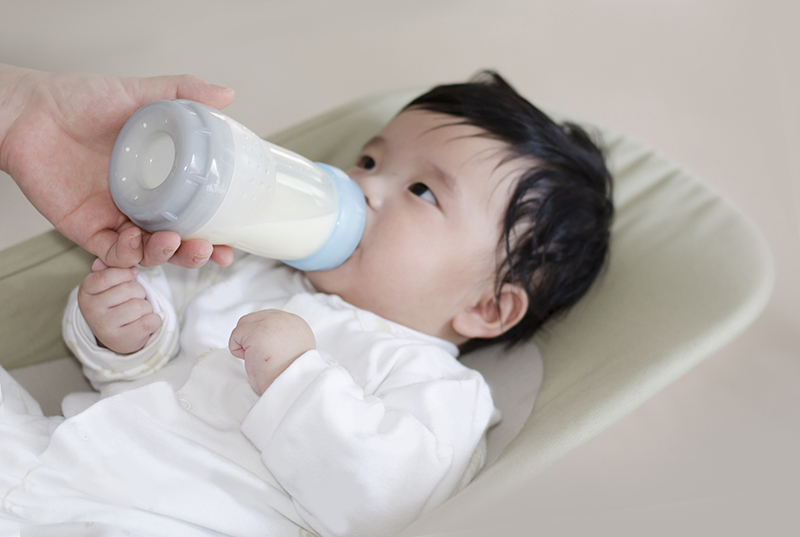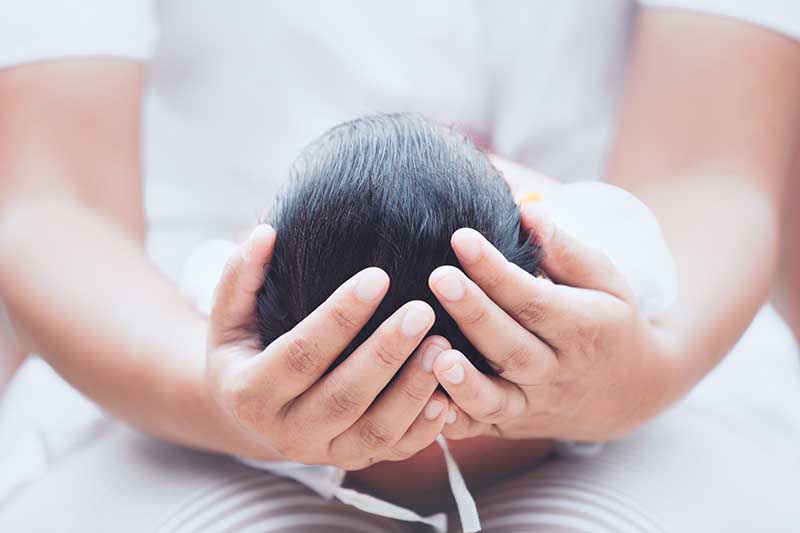Families For Life | Bottle-Feeding Babies: Giving the Bottle-Newborn

Bottle-feeding babies takes a bit of practice. But once you know how to bottle-feed your baby, it’ll be a warm and comfortable experience for both of you.
Bottle-feeding basics: getting the temperature right
It won’t hurt your baby to have cold infant formula or expressed breastmilk, but many babies prefer their milk warmed to at least room temperature. If your baby doesn’t mind cold formula or milk, feel free to serve it cold.
Standing the bottle in warm to hot water is the safest way of warming formula or breastmilk.
Bottle warmers are convenient and safe as long as they have a thermostat control. Leaving the bottle in the warmer for more than 10 minutes might cause bacteria to breed in the formula or milk. These bacteria are a common cause of diarrhoea.
Microwaves aren’t the safest way to warm formula or milk, because they don’t warm it evenly, and ‘hot spots’ in the liquid might burn your baby’s mouth. Closed bottles can also explode in the microwave. Microwaving breastmilk might also damage or destroy some of breastmilk’s nutrients.
Mix the formula or milk in the bottle to make sure the temperature is even. Take particular care to mix breastmilk gently, because vigorous shaking can harm it.
Check the temperature of the feed by shaking a little formula or milk from the teat onto the inside of your wrist. It should be about room temperature.
If your baby can’t always feed directly from your breast, you can bottle-feed her expressed breastmilk. This will keep up your milk supply and make sure baby gets the benefits of breastmilk.
Getting formula or milk to flow when bottle-feeding
To test the flow of the formula or milk, hold the bottle upside down when it’s filled with liquid at room temperature. The liquid should drip steadily but not pour out.
If you have to shake it vigorously to see the drip, the flow is too slow. Your baby might go to sleep before he drinks what he needs.
A little leakage at the corners of baby’s mouth while she feeds is nothing to worry about – as she gets older this will stop.
If you have trouble finding the perfect teat, go for a faster teat rather than a slow one.
Giving baby the bottle
Make yourself comfortable and cuddle your baby close to you, holding him gently but firmly. It’s better for him to be on a slight incline so any air bubbles rise to the top, making burping easier.
Put the teat against baby’s lips. She’ll open her mouth and start to suck. Keep the neck of the bottle at an angle so it’s filled with formula or milk.
When your baby stops sucking strongly or when he has drunk about half the formula or milk, gently remove the bottle and see whether he wants to burp. Once you’ve tried burping your baby, you can offer the bottle again.
It’s a good idea to change the direction your baby is facing for part of the feed or at different feeds. This helps to stimulate your baby’s senses equally.
When baby doesn’t finish the bottle
If your baby goes to sleep, put her over your shoulder, rub her back, and stroke her head, legs and tummy to wake her up. A nappy change is a good way to wake her up if that doesn’t work.
Wait until your baby is properly awake before offering him the rest of the formula or milk.
If your baby doesn’t want to finish the bottle don’t encourage her to, because she might have had enough. Let her decide how much she wants.
Holding, cuddling and talking to your baby while he’s feeding will help him develop and grow. You can read more about bonding with your newborn.
How much do bottle-feeding babies drink?
There’s no set amount of food or number of feeds your baby should have. Different babies drink different amounts of formula or milk. Some might have some feeds close together and others further apart.
The following is a general guide:
Formula-fed babies need around 150-200 ml of formula per kilogram of body weight per day until three months old, then 120 ml per kilogram of body weight. For example, a one-month-old baby who weighs 4 kg might have 600-800 ml of formula a day or a 5-month-old baby who weighs 7kg might have 840 ml of formula a day.
Breastfed babies take an average of 750-800 ml of breastmilk per day from one month until about six months. But this can vary a lot between babies.
Babies commonly have 6-8 feeds every 24 hours, but this will vary depending on their needs and the length of feeds – feed your baby whenever she’s hungry.
You can also use the chart on the formula tin to see how much infant formula to give, but information about quantity for age on formula tins is just a guide. It might not necessarily suit your baby.
Some babies never drink the ‘required amount’ for their age and size, and others need more. Plenty of wet nappies, consistent but not excessive weight gains, and a thriving, active baby mean all is well.
Dangers of bottle-feeding in bed
Choking risks
Babies who fall asleep while bottle-feeding can draw liquid into their lungs. They might then choke on it or inhale it. This is like what happens when you have something ‘go down the wrong way’.
It’s more dangerous for your baby than it is for you, though, because your baby isn’t as good at waking up if something interferes with breathing.
Although it’s more likely that your baby will cough and be uncomfortable, you might want to avoid the risk altogether.
Sleep associations
If babies get used to having a bottle-feed every time they fall asleep, they might develop an association between the bottle and sleep. They might then find it hard to fall asleep without a bottle.
Risk of tooth decay
Milk is quite high in sugar. Soaking your baby’s teeth in it overnight can cause tooth decay.
Risk of ear infections
When a baby drinks lying down, milk can flow through to the ear cavity, which can cause ear infections.
Holding your baby during bottle-feeding can help you bond and connect. It’s better for your relationship than propping your baby up in bed with a bottle. It’s also a great opportunity for you and your spouse to take turns bonding with your baby.
Using a feeding cup
When your baby is around six months old, you can start using a feeding cup to teach your baby how to sip drinks from a cup. You should continue to thoroughly wash the feeding cups containing infant formula or breastmilk until your baby is 12 months old.
© raisingchildren.net.au, translated and adapted with permission
Explore more

DID YOU KNOW??
Cradle cap is the oily, scaly crust that babies sometimes get on their scalps, in their body folds and on their torsos. Although cradle cap looks uncomfortable, it doesn’t usually bother your baby.
READ MORE